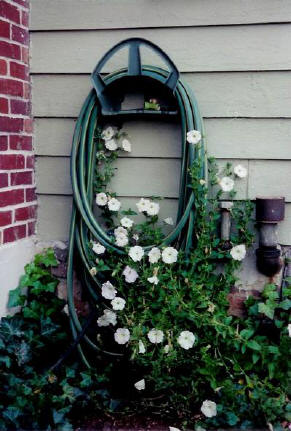Betty Jakum
Adams County Master Gardener
 A few years ago some petunias grew in my garden where none had grown before. I certainly hadn’t planted them; but the fall before, I had worked up the soil in that area to rid
it of an infestation of English ivy. To my surprise the next spring the bare earth yielded wonderful multicolored petunias that practically climbed up a garden hose and filled the early evening air with a sweet fragrant aroma. They have returned every year since.
A few years ago some petunias grew in my garden where none had grown before. I certainly hadn’t planted them; but the fall before, I had worked up the soil in that area to rid
it of an infestation of English ivy. To my surprise the next spring the bare earth yielded wonderful multicolored petunias that practically climbed up a garden hose and filled the early evening air with a sweet fragrant aroma. They have returned every year since.
What variety of petunia was growing in my garden? Who had planted the seeds? Where did they come from? A search through some seed catalogs and a visit to the internet came up with a possible answer. There I discovered a petunia listed as an
Old-Fashioned Vining Petunia (Petunia multiflora). It was an heirloom variety that had been abandoned by commercial growers years ago yet, according to one catalog, had been preserved by the few who remembered it growing in their grandmothers’ gardens. It described my
petunias perfectly, self-seeders with the same sweet scent, color variation and climbing habit.
|

If you think the photo needs one: A vining petunia climbs its way up the garden hose. This particular plant produced mostly white and lightly-tinged flowers, as this heirloom sometimes does.
|
Who planted them and where they came from are still secrets known only to some long-ago occupant of my old farmhouse, but that doesn’t keep me from enjoying and appreciating these wonderful little marvels from the past.
After the discovery of my vining petunia, it didn’t take me long to become fascinated with other heirloom plants. I found, ironically, that these living pieces of history add a newness and vitality to the gardening experience. Because many of us are
unfamiliar with heirloom varieties, discovering them is like unearthing an entirely different grouping of plants, most of which we’ve never seen before. This can be pure joy for most gardeners who are always looking for the exciting and new in flower and vegetable
varieties.
What is an heirloom plant? An heirloom plant is an open-pollinated cultivar that was commonly grown during earlier times but is no longer used in today’s large-scale agribusiness. Open-pollinated means that a particular plant can be grown from seed
and will come back "true to type," with the next generation looking just like the present one. If you plant an heirloom tomato like a Brandywine, for example, then collect the seeds from the mature plant and process them properly, the plants from these seeds will grow and
produce exactly like the Brandywine tomatoes they were taken from. You cannot do this with hybrid tomato varieties because they do not have the ability to reproduce themselves.
Plants are generally considered heirlooms when they can be traced back 100 to 150 years, although many old European, African and Asian plants go back much farther than these dates. Some Native American crops are believed to be pre-Columbian.
Why do people grow heirloom plants? There are many reasons why people grow heirlooms today. Some want to surround themselves with heirloom flowers that remind them of their mothers or grandmothers’ gardens. Like my vining petunia, they may want a
petunia with a wonderful fragrance that is hardy, relatively pest free, and blooms freely until frost, long after most hybridized varieties have become leggy and their flowers have faded.
Others are drawn to heirloom vegetables for their variety and flavor. They may want a tomato or a cantaloupe that tastes like those they remember as children. Modern large scale growers are more interested in producing vegetables that are uniform in
size, ripen all at once, have the same color and shape, and can be transported to market without spoilage. Flavor is usually pretty low on their priority list.
Some people grow heirloom plants because doing so gives them a sense of history and cultural heritage. This might be no place truer than in Pennsylvania. Because of the rich tradition and outstanding farming abilities of the Pennsylvania Germans who
settled large areas of the state, many heirloom varieties originated here. According to information provided by the Landis Valley Museum Heirloom Seed Project, the Brandywine Tomato was first offered by a Pennsylvania seed man in the late 1800s. Legend has it that another
heirloom tomato, the Howard German, came from seed sold by a woman at a Harrisburg farmer’s market who said the seed was originally from the "old country." Both the Grandma Stober’s Chow-Chow Bean and the Mull Kidney Bean were originally grown on farms in Lancaster County.
And the list could go on.
And perhaps it will. In another column appearing in a few weeks, we will continue to discuss the benefits of heirloom plants and learn where they can be purchased. We will also detail some of the more readily available and easy-to-grow heirloom
plants that you might want to try planting in your garden this year to capture your own little piece of the past through plants.
Read other articles on plants and gardens